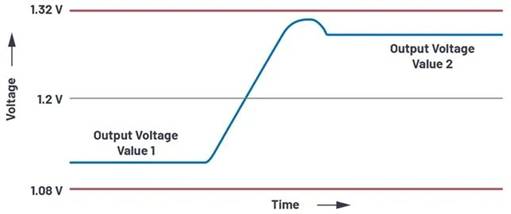The function of dynamic voltage regulation (DVS)
Time:2022-08-18
Views:1869
A voltage regulator is generally used to generate a constant output voltage. With the control loop, a stable and accurate output voltage can be generated through the unregulated input voltage. What is the role of dynamic voltage regulation (DVS)?
Improve the conversion efficiency of PFC stage under light load operation



Dynamic voltage regulation means that the output voltage of the power supply can be regulated during operation. There are several reasons for such adjustments.
Improve the conversion efficiency of PFC stage under light load operation
The power factor correction (PFC) stage for power compensation can raise the AC voltage of the grid voltage to the DC intermediate circuit voltage. In a 240 V AC system, the intermediate circuit voltage is generally 380 V, as shown in Fig. 1. The adp1047 PFC controller can use DVS to independently reduce the output voltage load, for example, to 360 V without affecting the set 380 V voltage. This can improve the conversion efficiency of the power supply during partial load operation.

Figure 1. Adp1047 PFC stage with downstream adp1046 DC-DC converter.
The microcontroller operates efficiently under various working conditions
Another example of DVS usage is shown in Figure 2. In this example, the adp2147 buck switching regulator supplies power to the digital signal processor (DSP). In many applications, microcontroller, DSP or FPGA can be used to improve system efficiency by reducing the core voltage when the processor is in standby mode. In VDD_ When the int voltage (core voltage) decreases (for example, when the DSP operates under low load, it decreases from 1.2 V to 1.0 V), a variety of DSPs, including adsp-bf527 provided by Adi, can operate more efficiently. The power consumption of a processor is largely proportional to the square of its clock frequency and operating voltage. Reduce the power supply voltage of adsp-bf527 by 25%, and the dynamic power consumption will be reduced by more than 40%. Many DSPs of ADI have similar characteristics.

Figure 2. The adp2147 switching regulator with DVS function can realize the efficient operation of adsp-bf527.
Improve recovery speed after load transient
As shown in the previous two examples, the common reason for using DVS is to improve efficiency or reduce losses. However, there are other interesting applications. Many systems require a precisely regulated supply voltage. For the voltage range shown in Fig. 3, a 1.2 V core voltage can be used. The voltage may be 1.2 V ± 10%. In this example, the voltage is kept constant under static load and dynamic load change. If the feedback control is set in the middle of the allowable range, half of the range is applicable to the static error source and also to the dynamic voltage change after the load transient. There is a trick, that is, slightly increase the output voltage at low load and slightly decrease the output voltage at high load. In the case of high load, sometimes lower load will be adopted, and small voltage overshoot will generally occur at this time. This voltage overshoot can be kept within the allowable range by slightly reducing the set point voltage of the high load, as shown in Fig. 3. The left side is high load and the right side is low load.

Figure 3. Dynamic regulation of power supply voltage based on load current.
The opposite naturally applies. When the load is low, it will rise at a certain point in time. Voltage overshoot may occur dynamically. At low loads, the voltage rises slightly and therefore remains within the allowable range. For this characteristic, it is usually called voltage automatic positioning.
In addition to the above applications, there are many other applications where dynamically varying voltages are also advantageous. Such as controlling a DC motor, operating an actuator, or driving Peltier elements for temperature regulation. Dynamic voltage regulation refers to the voltage generated by dynamic regulation, which is very helpful and even necessary for many applications. Especially in digital control power supply, DVS is very common and easy to realize.
|
Disclaimer: This article is transferred from other platforms and does not represent the views and positions of this site. If there is infringement or objection, please contact us to del |











